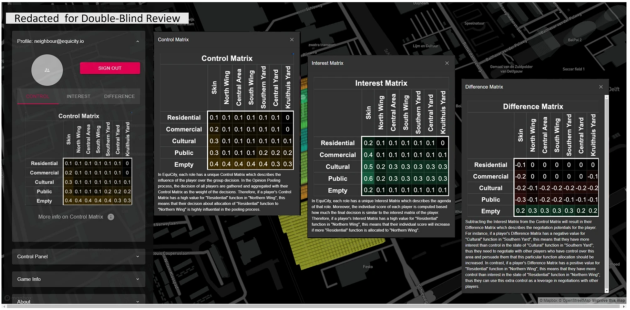Planning Support Systems
The EquiCity Game: Promoting fair decision-making in urban planning
6 min
Learn how researchers built a simulation platform to tackle the complex challenge of multiple stakeholders in urban building projects.
Collaboratively forming multi-functional urban building projects is a very complex process. It involves different types of stakeholders, each with their own agenda and priorities. Allocating shared public budgets and resources in a way that satisfies all participants is quite a challenge, especially when it comes to honouring the interests of less vocal stakeholders.
To tackle this challenge, researchers developed a mathematical approach to equitable decision-making in spatial development. They translated this approach into a simulation platform dubbed the EquiCity Game.
The game was built on a web-based system that acts like a digital twin of a city area, using open-source libraries and tools and freely available resources.
Researchers designed the EquiCity Game to support group decision-making without oversimplifying the challenges. It helps players balance limited resources while achieving sustainability goals in three categories: social-economic equity, economic-environmental efficiency, and environmental-social comfort.
The researchers realised that solutions that fully satisfy the needs and wishes of all those involved are an illusion.
Instead of pursuing optimisation, they chose a more realistic and flexible approach, aimed primarily at positively reinforcing constructive negotiations during the game.
Researchers designed the game to help people participate in making decisions in three stages of the urban design process: pre-planning, planning, and massing.
Pre-planning is about what goes where. In this stage, stakeholders can define types of space by sharing their opinions on how to divide resources among various areas or buildings. The system then combines everyone's input into a shared plan using algebraic opinion pooling. This is a method for fairly combining different people's opinions into one common decision.
The planning stage aims to determine the allocation of each type of space across each site. To make sure local space allocations match overall targets, a method called algebraic iterative proportional fitting is used to perform the calculations. Algebraic iterative proportional fitting is a method that allows for adjusting data to meet specific goals without losing the original data patterns.
The third and final stage is about how to shape the buildings architecturally. This is done using voxels (3D cubes).
The game has an interactive interface (front end), where players can view maps and environmental data and make decisions for each game round. Each player can see their personal scores and objectives, adjust how much of each space type goes to each site, set weights for building design goals, and add comments to explain their choices.
Once all players have submitted their decisions, the game engine (back end) processes everything, which results in updated system information.

Screenshots of the game interface showing the information panels presented to the players. Image: Nourian et al. (2024).
After the game has been played, it's time to judge the quality of the urban space design that was developed during play.
The game features three avenues of evaluation.
The first looks at what needs to be changed in terms of allocation per site compared to the current situation. The second assesses how much solar energy an area could produce in the new situation, and the third investigates the efficiency of transportation between different zones.
Researchers tested the EquiCity Game in workshops guided by a game master.
In these workshops, participants role-played working on a fictional project to turn an old factory into a dense urban neighbourhood. Their primary challenge was to find the right balance between preserving cultural heritage and adding the necessary new housing.
After the workshops, an analytic dashboard was created to show how players negotiated and made decisions during the game.

Screenshots of two iterations of gameplay: the redevelopment of a former factory into an urban district. Image: Nourian et al. (2024)
The researchers conclude that the EquiCity Game can speed up the typically slow process of reaching group consensus in city planning. Thanks to its accessibility and scalability, it has the potential to significantly contribute to participatory decision-making.
Areas for improvement include adding a procedure for measuring the equity that the game strives to support and enhancing realism by including cost-sharing and budget limits.
The researchers encourage others to use and test the game, especially to find a good balance between reaching group consensus and meeting objective quality goals.
This story is an adaptation of a journal article: Nourian, P., Azadi, S., Bai, N., de Andrade, B., Abu Zaid, N., Rezvani, S., & Pereira Roders, A. (2024). EquiCity game: a mathematical serious game for participatory design of spatial configurations. Scientific reports, 14(1), 10912. It has been adapted with permission from the authors and in accordance with the copyright license CC BY 4.0.
To read the original article, follow the link below: